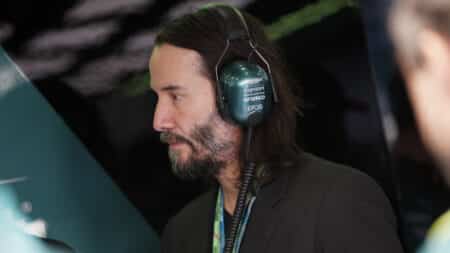
Keanu Reeves to chronicle birth of Cadillac F1 team in new docuseries
Hollywood star to tell "remarkable" story of American bid to join Formula 1 elite ahead of 2026 debut
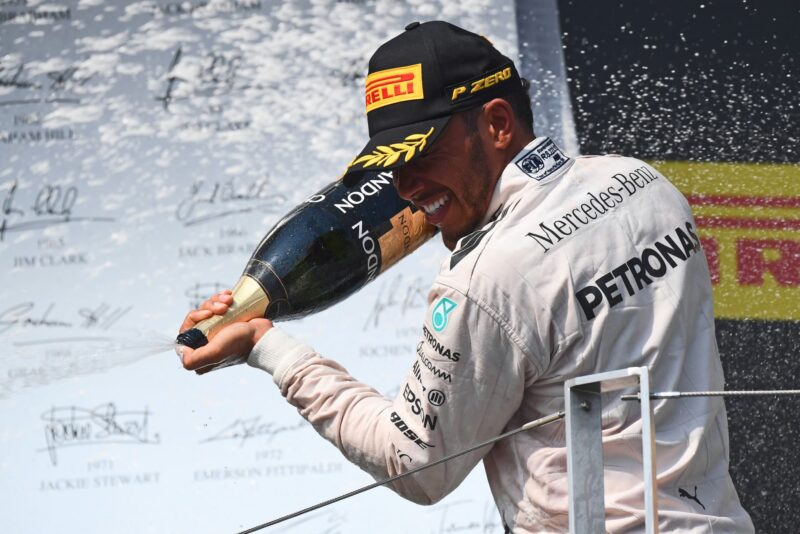
Grand Prix Photo
In the dazzling sunlight of a Budapest summer afternoon, it looked a closer fight than it really was. In his victory drive Lewis Hamilton several times gave the impression he was struggling, even to the point of Mercedes threatening to pit Nico Rosberg before him, putting his win in jeopardy with the dreaded undercut, as Nico would have used the grip boost of new tyres to overcome the small deficit to Lewis who would have been obliged to struggle for another lap on old rubber. But in reality that was never going to happen – as Hamilton always had pace in hand.
Red Bull initially looked closer to Mercedes than it really was too. Daniel Ricciardo even briefly swept around Rosberg to go second in the opening moments of the race and although Nico had retaliated by the next corner, Ricciardo kept the Mercs in sight through the first stint of the two-stop race and even briefly tried to put strategy pressure on Rosberg. But that was an illusion of Hamilton’s tyre management. In reality the Mercedes advantage over the field was every bit as big as usual.
Two very good Red Bull/Ferrari fights developed later in the race as Ricciardo held off Sebastian Vettel’s challenges a few seconds ahead of Max Verstappen who was repelling Kimi Räikkönen – again – for lap after lap. This latter fight got a little fraught as the teenager stretched the rules of etiquette in battle almost to breaking point. Kimi even felt moved to talk about it afterwards…
But even those struggles were derived from the trick of the light that was the controlled pace of Hamilton. It was because the Mercs appeared tantalisingly within reach that Red Bull pitted Ricciardo early, trying to pressure Mercedes into doing likewise – but all that did, as Merc turned up the volume, was to leave Daniel well behind and put him on tyres that were eight laps older than those of Vettel in the last stint, thereby bringing the Ferrari closer than it would otherwise have been. Similarly Verstappen was at a big tyre disadvantage to Räikkönen who – because he had qualified outside the top 10 – had been able to start on the more durable soft and run long, enabling him to be on new super-softs for stints two and three.
It was a tyre-limited race, run at a fairly gentle pace. Though as it turned out, the tyres held on much better than generally expected. But that couldn’t be known before the race, as Hamilton explained. “Like I’ve said before, when you have races where you have to manage the tyres it’s like you have $100 to spend in the casino, so you have to spend it wisely. You only have so much energy in the tyres. We didn’t know for sure if it was a two- or a three-stop race because the track temperatures were so high, so there was no need to be risking anything. I had a target number of laps to get to in making the strategy work, and so once I was in the lead I was able to just manage my tyres.”
Just as in China last year, it was tempting to ponder whether Lewis’ tyre management might’ve been a little over-zealous in order to back Rosberg – his title rival – into the cars behind. “No, it wasn’t that,” insisted Toto Wolff. Maybe it wasn’t. “No, he just didn’t have the big picture sitting inside the car, didn’t know that the train was coming behind, and that we needed him to up the pace so that Nico wasn’t under threat.” But it was amusing all the same to note that when he was initially asked to get a move on, he responded with: “Yeah, I’m working on it.” But when it was suggested that if he didn’t, Rosberg would be brought in before him, Hamilton somehow found the time from somewhere. It was a similar story when Rosberg a couple of times used the lapped traffic to get himself onto Hamilton’s tail – and Lewis was able to get himself out of DRS reach immediately.
Rosberg thus lost the lead of the championship for the first time this season, marking the two-year extension of his contract with a slightly passive race to second despite having set pole – albeit in slightly controversial circumstances. On Saturday evening Hamilton had campaigned race director Charlie Whiting very hard to investigate whether Rosberg had lifted off enough for double waved yellows on his pole lap, for a Fernando Alonso spin had cost Hamilton an almost-certain pole. It can be imagined what sort of internal tension that might have brought to the team. But this is a world championship being fought out. Hamilton is just as skilled at inducing pressure off the track as on, walking that line of plausible deniability.
Mercedes doesn’t have the monopoly on competitive tension, either. At Red Bull Verstappen was deeply frustrated with his afternoon, feeling that being held at the pace Ricciardo in front of him was maintaining put him behind the Ferraris unnecessarily after the first stops. He stopped short of saying he thought his team-mate had backed him into them. But only just… Sparks beginning to fly everywhere behind F1’s smoked glass.
Qualifying
The randomising effect of a pre-qualifying thunderstorm gave Hamilton with one hand what it took away with the other, leaving Rosberg sitting pretty on pole.
The wet but drying track made it more about improvisation in the moment than the fine details of set up and tyre usage, overturning the big disadvantage Hamilton was suffering from having missed most of Friday afternoon practice, courtesy of his crashing at turn 11. “Sometimes a missed practice session doesn’t make too much difference but this is such a technical track it had really put me on the back foot – so I was glad of the rain actually.” A grippy, smooth new track surface and changes to the kerbs had changed the track, allowing the cars to run lower, increasing their aero grip.
So sudden and heavy was the storm that Q1 took over an hour to complete; four red flags and three accidents (accounting for Marcus Ericsson, Felipe Massa and Rio Haryanto) as cars aquaplaned out of control and only luck determined whether you got away with it. The final red flag came at just the moment Jolyon Palmer looked poised to repeat his practice form by getting the Renault through to Q2. Although this left him a disappointed 17th – ahead of Massa, team-mate Kevin Magnussen, Ericsson and the Manors of Pascal Wehrlein and Haryanto – Palmer had made something of a breakthrough this weekend, helped by suspension updates to the Renault.
Q2 began on inters, ended on dries – and where you were on track as the clock counted down was crucial. This caught out Ferrari with Kimi Räikkönen who went P1 as he completed his lap but was down to 14th by the time everyone else after him got a progressively drier track. Hamilton only got through this part by the skin of his teeth. Romain Grosjean just missed out, the Haas ahead of Daniil Kvyat’s Toro Rosso (critical of the team for putting him out in traffic), Sergio Pérez’s Force India, Räikkönen, Esteban Gutiérrez’s Haas and Felipe Nasr’s Sauber. Mercedes, Red Bull and McLaren were the only teams to get both their cars through to Q3 where they were joined by Vettel’s Ferrari, Hulkenberg’s Force India, Bottas’ Williams and Carlos Sainz’s Toro Rosso.
Hamilton was quickest on the first super-soft runs, marginally ahead of his team-mate but on the final runs Hamilton was almost 0.4s faster through the first sector. Unfortunately for him, just up ahead was Alonso who was about to have a moment that would largely determine the grid. Fernando had starred in the conditions, maximising the McLaren at a track where its power shortfall is not so costly. He’d been fifth quickest on the first runs but an error going into the chicane compromised his final lap with the track at its quickest. He then spun the car through turn nine and brought it to a halt broadside still partly on track, raising some suspicious eyebrows.
Hamilton was the first upon the scene and was forced to slow, his lap ruined. The others – including Rosberg, Ricciardo, Jenson Button, Vettel and Carlos Sainz – had to back off for the double waved yellow flags, but their laps weren’t necessarily ruined. The track was gaining grip so quickly that it was still possible to lift for the yellows but proceed to improve your lap time. Which is precisely what Rosberg and Ricciardo did – Nico’s lap eclipsing Hamilton’s first run time to take pole, with Daniel just a tenth behind in third. Vettel, following behind Button, was frustrated that Jenson didn’t initially seem to realise that it was still possible to improve. “Jenson was sleeping, I think,” said Seb. “He didn’t expect anyone to keep pushing and backed off but didn’t move out of the way through turn 12. By turn 13 he had realised and did move but by then I’d lost a lot of time. It’s a bit of a shame. We did some changes after P3 and I think they worked. The car was really coming alive, but we couldn’t show that.”
It left Vettel back in fifth, behind the Red Bull of Verstappen who missed out on a second Q3 run through a communication mix-up as he backed off on his preparation lap to give himself more room to the car in front – without realising he was running out of time to get across the line. This left him relying on his first run, still enough to make an all Red Bull second row.
Sainz was left relying on his first Q3 run – which was good for sixth – as he was caught behind Button after the yellow flags. But he was nonetheless delighted with the outcome, having reckoned the Toro Rosso wouldn’t have made Q3 in the dry. He invariably stars in variable conditions and did so yet again here.
The spun Alonso and the compromised Button put their McLarens seventh and eighth respectively – ahead of Hulkenberg and Bottas, the latter running Williams’ new floor, with Massa still on the old one.
There was a bureaucratic farce later on as the wet and interrupted Q1 had meant that several cars had failed to record a time within 107% of the fastest – including several of those which made it through to Q2 and even Q3. How this impacted upon the grid order was discussed long into the night before sense prevailed (with the help of Force India) and the order was left alone.
Race
The front four moved off almost as one as the lights went out but crucially Hamilton’s start was just a little bit better than Rosberg’s, Lewis out-dragging his team-mate and grinding ahead up the inside. With Lewis doing that and Ricciardo going for Rosberg’s outside into the braking area, Nico was somewhat passive in staying in the middle of the track. He had time to cut across Hamilton and prevent his advance but chose not to. Ricciardo went around the outside through the looping turn one and for a moment looked as though he was about to take the lead but cement dust towards the exit of the corner meant he didn’t quite have the grip to carry the necessary momentum. Hamilton emerged ahead, with Rosberg towing behind Ricciardo on the downhill run down to turn two and diving back ahead into there. Being out-gunned off the line essentially defined Rosberg’s race. Hamilton was now in control.
Behind them ran Verstappen, Vettel, Alonso, Sainz, Button, Bottas, Hulkenberg and the rest. Ericsson had started from the pitlane in a replacement chassis (number two, the car that Nasr found so difficult in the early races). Massa’s steering valve had not been set 100% correctly after his accident the day before, giving him very heavy steering one way, very light the other, and he would make little progress from his 18th-place grid slot. Most began the race on the super-soft tyre for its initial performance off the grid, with only Kvyat, Pérez, Räikkönen, Palmer, Massa and Ericsson going for the soft. Pérez was intending to have a set of mediums fitted later and then to run to the end, though a one-stop would prove optimistic and Force India would bail out of it. Kvyat suffered a problem with the engine settings at the start, wheel-spinning away many positions to be running near the back, his season going from bad to worse. Going in the other direction, Wehrlein had made his usual great start and opening few corners, jumping six places, but he’d inevitably sink back down to the Manor’s natural level later.
Räikkönen began to ease his way through the slower traffic, going past Pérez and Gutiérrez quickly enough but then coming up against an immovable object in Grosjean’s Haas, which was running 11th, just behind Hulkenberg.
Hamilton sprinted away from the pack, easing himself out of Rosberg’s DRS reach even before completion of the opening lap. That done, he then backed off – as did pretty much everyone else. The super-soft was prone to thermal degradation in this heat around these long corners and needed to be looked after. Push it too hard and you’d be in for a disastrously early stop and maybe having to switch to a slower thee-stop. So once the initial dicing was done, there was a period of stalemate. You could hear how Hamilton had the Mercedes almost straight after the final corner before giving it anything like full throttle.
Ideally to give the tyres an easier time, as well as setting a fairly gentle pace, you needed to back away from the turbulence of the car ahead, so Rosberg backed off from Hamilton, Ricciardo dropped away from Rosberg, Verstappen was instructed likewise to gap to Ricciardo while Vettel dropped a few car lengths back from Max. This wasn’t the racy part of the race. But those cars still had more pace than could be run by Alonso and Sainz who in turn pulled away from Bottas and Hulkenberg. Verstappen was clearly somewhat frustrated at this style of ‘racing’ radioing in that, “I’m driving like a grandmother”.
A little indication of just how slowly everyone was driving came when Button was forced to pit on lap seven and rejoined at the back. With his race essentially ruined he clearly wasn’t much concerned about tyre degradation and he began setting fastest sector times… He’d suffered a hydraulics problem that sent his brake pedal to the floor. The instructions he was given to affect a cure were judged to have transgressed the latest radio restrictions and he was served with a stop-go penalty. “A brake pedal going to the floor isn’t a safety issue?” asked Button incredulously.
The super-soft phase of the race was expected to last maybe 10 laps before everyone’s left-rears began to surrender. But in the event, they did rather better than that. Although thermal degradation remained a limiting factor, the expected graining of the rears was much reduced in these higher track temperatures on this scorching day.
Vettel was the first to begin to force the issue, stepping up the pace to close the gap to Verstappen, Ferrari intending to go for the undercut. Max responded but was then brought short by the proximity of his team-mate ahead. By the 14th lap Vettel pitted from just one second behind Verstappen and the Ferrari stop was slick as a new set of softs were fitted. Max was essentially doomed now to exit behind Vettel whenever he made his stop. Hence Red Bull brought Ricciardo in first – before Vettel could threaten his position. The challenge for Verstappen now was to have a pit stop’s worth of a gap over the other Ferrari of Räikkönen, which on its harder tyres, would be running very long. Red Bull was helped in this by the fact that Kimi was still trapped behind Grosjean and therefore running slower than Verstappen so that by lap 13 Max had got the necessary 20s gap and by lap 14 it was out to over 22s. But as Grosjean pitted out of Räikkönen’s way on that very lap, Kimi’s pace improved by 1.5s – which was faster than Max could conjure. It was now urgent he be brought in. As he pitted on the 16th lap, he still had just about enough of a margin. But he didn’t keep his foot hard enough on the brake as he rolled to a stop. The car crept forward – causing a delay with the fitment of the left-front wheel. As he left the pitlane, Räikkönen’s Ferrari – which would be running for another 13 laps before stopping – flashed by on the left, much to Max’s dismay. “It was very frustrating to be behind a Ferrari at the start [of the stint] on my fresher tyres. It was a shame because at the beginning we were quick and I tried to create a gap to the Ferraris which led to me having to back off as I got too close to the car in front.” The car in front having been his team-mate Ricciardo…
The old-tyred pace that Räikkönen imposed upon Verstappen meant that Ricciardo and co. escaped off into the distance. Several times Verstappen tried to attack Räikkönen into turn two, but always Kimi held sway and Max succeeded only in using up his tyre life. In hindsight, should Red Bull have brought in Verstappen first, thus ensuring he came out ahead of Räikkönen? There were two problems with that. One: it might have allowed Verstappen to undercut ahead of Ricciardo. Secondly, it would also have exposed Ricciardo to more of an undercut threat from the new-tyred Vettel. In live time Red Bull didn’t really have a choice and besides, Verstappen in theory had pitted still with enough of a gap over Kimi. It was Max’s small pitlane error which made that not so.
What Red Bull was also hoping was that Daniel’s lap 15 stop might push Mercedes into bringing Rosberg in earlier than planned. It wasn’t so much that it was close enough to threaten the undercut on Nico – who was over five seconds ahead – but that it would extend the number of laps the Merc would be obliged to do on its next set of tyres and Red Bull might then be able to be stronger at the end of the stint. But the closeness was an illusion. Mercedes knew this and was in no hurry to respond to the Ricciardo stop. On lap 16 Hamilton came in from 2.5s in front of Rosberg and was fitted with new softs. Nico would be in a lap later for the same.
Behind the Mercedes/Red Bull/Ferrari group, Alonso and Sainz continued to hold sway. They exited the stops behind the long-running harder-tyred cars of Pérez and Palmer, the latter enjoying the Renault’s new-found performance. Bottas remained ahead of Hulkenberg a little further back, the Williams and Force India proving very evenly matched. When Pérez eventually pitted for his mediums on what was scheduled to be his only stop, he came out ahead of Hulkenberg, with Palmer just behind them. Hulk and Palmer had a pit stop race at the second stops, won by Palmer who was looking good for his first points. Being able to compete with Force India underlined just how improved the Renault was here. Team-mate Magnussen was a couple of places back.
Hamilton was very conservative on his fresh softs in the early laps of this stint, making sure he didn’t overwork them. Rosberg was suddenly right with him as a result, much of the earlier 2.5s gap now wiped. This was when things began getting tense on the Mercedes pit wall. Lewis was setting a pace slower than Ricciardo in third who was thus gaining on Rosberg and potentially making him an undercut threat up to the second stops. “I’m struggling for pace,” said Lewis over the radio, perhaps disingenuously. He was lapping in the mid-high 1m 26s – which was almost certainly a couple of seconds off the pace. This was more than the softs really required, but Hamilton was of course perfectly entitled to look after them as much as he judged prudent. Ricciardo was lapping up to a second faster and what had been a 7.5s gap was down to 2.9s by the 30th lap. Not only that, but Vettel was able to creep to within a couple of seconds of Ricciardo, the Ferrari treating its tyres well.
Räikkönen, having held Verstappen at bay for 13 laps, made his stop on lap 29 and had his first set of super-softs fitted. It was now his task to get these to last long enough that he could have another set of them at his second stop. Upon rejoining he quickly dealt with Alonso at turn one.
Hamilton was asked a couple of times to up his pace as things got tense at Mercedes. “It’s not like I’m driving slow,” he insisted. It was explained to him that if he couldn’t increase his pace, Mercedes would have to bring Rosberg in first, “which would put the win in jeopardy.” That seemed to do the trick and by the 30th lap Ricciardo and Vettel were no longer making gains upon them.
Red Bull decided at this point to pull the trigger early on the second stops with Ricciardo, bringing him in on lap 33 from a couple of seconds behind Rosberg. As well as again trying to exert some pressure on Rosberg, it also defended against any undercut threat from Vettel. There was no response from Mercedes and Ricciardo was now consigned to a long final stint. Vettel stopped eight laps later, hoping to mount a late attack on the Red Bull.
Hamilton came in for his second stop on the 41st lap, Rosberg a lap later. The earlier stop boosted Hamilton’s lead to 4.5s but again Lewis was setting a very conservative pace and Rosberg was soon back upon him. There was no longer a threat from behind – Ricciardo being eight seconds back – but Hamilton continued this game of cat and mouse as he looked after the rubber.
Verstappen had used up the best of his tyres in his earlier attempts at passing Räikkönen and was brought in for his second stop on lap 38. Räikkönen, yet to make his second stop on his transposed tyre strategy, was 10s up the road and Max now had to set a strong enough pace that Räikkönen couldn’t get that gap out to the 20s that was required for a pit stop. This he comfortably managed to do and Räikkönen was 7s behind after calling in on lap 50. But with 20 laps still to go Kimi’s new super-softs were working just fine on the now light-fuelled Ferrari, allowing him to set what would stand as fastest lap of the race and to quickly close in on the older and harder-tyred Red Bull. Their battle would be renewed soon enough.
The downside risk of Hamilton’s conservative pace was how vulnerable it made him as the Mercs came to lap backmarkers. It’s a very difficult track on which to get out of the way, such is the interlinked nature of many of the corners and the amount of Pirelli chunks of rubber off line. Lapping the Grosjean-Palmer-Pérez gaggle allowed Rosberg to get within 0.6s of the leader. As Hamilton then sprinted off to get himself out of DRS range, he encountered Gutiérrez at an awkward section of track. It took a while before Esteban could respond to the blue flags – and Hamilton made his displeasure known by use of a single digit as he passed. The Haas driver would have a 5s penalty added to his time for the blue flag offence, but he’d still be ahead of team-mate Grosjean who had fallen behind him with a slow first pit stop. Gutiérrez had benefitted from Palmer spinning at turn four a few laps earlier, this losing Jolyon the chance of points though he remained well clear of Magnussen.
Once past Gutiérrez, Hamilton attacked for a lap or so to ease away from his team-mate. Not that Nico had ever looked like trying to aggressively capitalise on Hamilton’s delays. It happened again on lap 63, seven from the end, when Lewis locked up into turn one, shrouding Rosberg in tyre smoke. Nico got close, but Lewis pulled out the gap all over again in the twisty middle section. Ricciardo and Vettel were left ever-further distant as the true picture of Mercedes’ advantage emerged and what was enlivening the race now were two Red Bull-Ferrari battles as Vettel closed down Ricciardo’s old-tyred car and Verstappen/Räikkönen reprised their earlier dice.
We’ve seen before just how defensive Verstappen can be but he took it to a new level as Räikkönen tried a move down to turn two on the 59th lap. As the Ferrari moved for the inside of the left-hander Verstappen began easing that way and Kimi instead swooped to the right. Verstappen then eased that way too and a piece of front wing endplate was plucked off the Ferrari, Kimi locking up in avoidance and running wide. The Ferrari was still essentially OK and Kimi was soon back upon him and furious. Max had made more than the permitted one defensive move as far as he was concerned. Arrivabene complained to the race director who looked at footage of it but concluded Verstappen had not quite transgressed.
“The wing damage meant that I couldn’t quite get close enough to him through the final corner,” explained Kimi of the difficulty of trying a DRS pass at the end of the straight. But he gave it a go there into the penultimate lap, launching down the inside but with Max squeezing him out, forcing Kimi to lock up and run around the outside to avoid contact. “If he does it again, I hit him,” warned Kimi. But he never got quite close enough again. Vettel meanwhile was all over Ricciardo, definitely enjoying more grip, but Daniel had it covered.
As did Hamilton. Crossing the line a couple of seconds clear of Rosberg took him into the lead of the championship for the first time this season. The dicing Verstappen/Räikkönen in fifth and sixth were last of those not lapped, with Alonso and Sainz next, together the whole race but the McLaren always just out of the Toro Rosso’s reach. Bottas remained ahead of Hulkenberg at the tail-end of the top 10, Pérez having fallen from this dice as he surrendered on the planned one-stop. Arriving at the pits for a new set of softs, there was no-one there to meet him, a communication error between the pitwall and garage giving them a Red Bull Monaco type of embarrassment.
Would there be any embarrassment at the Mercedes debrief as they discussed Lewis suddenly finding that previously elusive pace? Quite possibly. But a small price to pay, surely.

Hollywood star to tell "remarkable" story of American bid to join Formula 1 elite ahead of 2026 debut
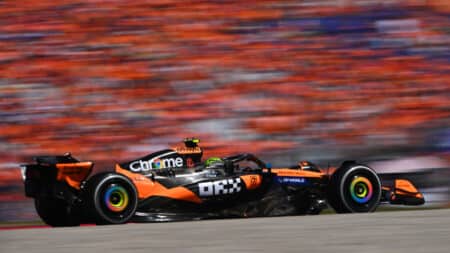
There's something about the Red Bull Ring that consistently brings out the very best in Lando Norris and McLaren — and last weekend's domination was just the latest chapter in a story that's been quietly building for six years
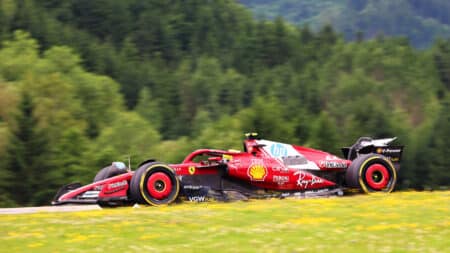
Ferrari's upgrades, and Hamilton's mastery of Silverstone, could offer him the chance to score his 10th home win
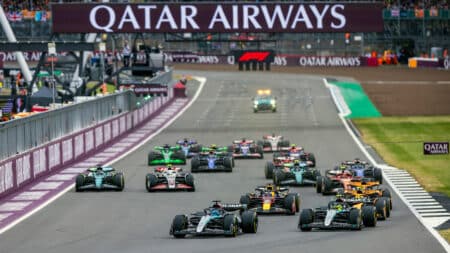
Watch F1 via live stream or on TV: dates and start time for the 2025 British Grand Prix, including all sessions